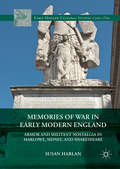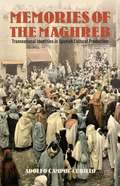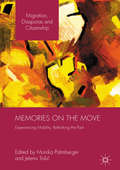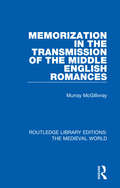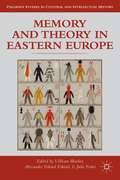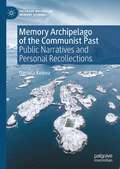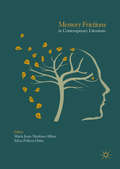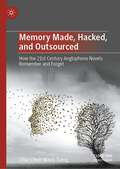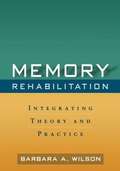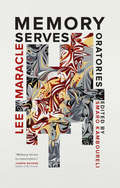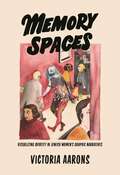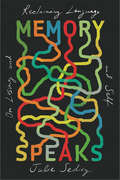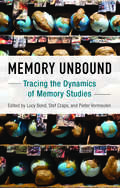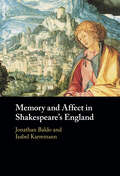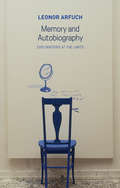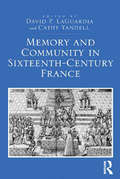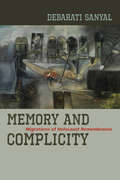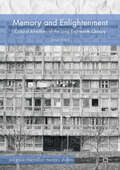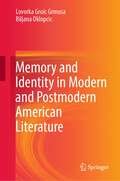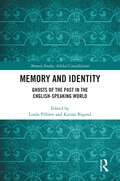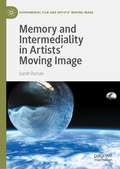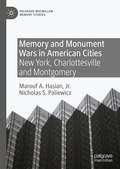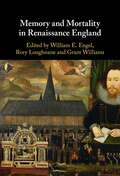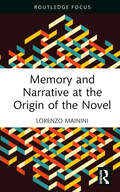- Table View
- List View
Memories of War in Early Modern England
by Susan HarlanThis book examines literary depictions of the construction and destruction of the armored male body in combat in relation to early modern English understandings of the past. Bringing together the fields of material culture and militarism, Susan Harlan argues that the notion of "spoiling" - or the sanctioned theft of the arms and armor of the vanquished in battle - provides a way of thinking about England's relationship to its violent cultural inheritance. She demonstrates how writers reconstituted the spoils of antiquity and the Middle Ages in an imagined military struggle between male bodies. An analysis of scenes of arming and disarming across texts by Christopher Marlowe and William Shakespeare and tributes to Sir Philip Sidney reveals a pervasive militant nostalgia: a cultural fascination with moribund models and technologies of war. Readers will not only gain a better understanding of humanism but also a new way of thinking about violence and cultural production in Renaissance England.
Memories of the Maghreb
by Adolfo Campoy-CubilloUsing a cultural studies approach, this book explores how the Spanish colonization of North Africa continues to haunt Spain's efforts to articulate a national identity that can accommodate both the country's diversity, brought about by immigration from its old colonies, and the postnational demands of its integration in the European Union.
Memories on the Move: Experiencing Mobility, Rethinking the Past (Migration, Diasporas and Citizenship)
by Monika Palmberger and Jelena Tošić‘Through a series of excellent essays this volume uses concrete ethnographic analyses of memory practices in different parts of the globe to offer theoretical reflections on how memory shapes and is shaped by mobility in time and space.’ - Marianne Hirsch, Columbia University, USA‘Memories on the Move is a brilliant edited volume that fills an important gap in the field of memory studies as it weaves together issues of mobility and remembering. Drawing on fine-grained ethnographical cases, it offers a rich and complex portrait of mnemonic constructions in the context of forced migration, exile and transnationalism. It is clearly a must-read for anthropologists, sociologists, historians and political scientists as well as for all scholars interested in the contemporary dynamics of memory, identity and mobility.’ – David Berliner, Université Libre de Bruxelles, Belgium‘This thought-provoking volume disentangles, ethnographically, the complexity of meaning-making practices of memory/forgetting in various contexts of (im)mobility.’ - Noel B. Salazar, University of Leuven, BelgiumBringing together vivid ethnographic material, this book opens up a timely conversation between memory and mobility/migration studies. It goes beyond the idea of the nation state as the primary unit of analysis to explore how people on the move use different forms and media of remembering to make sense of their lives and act as political subjects. Investigating when and by what means people on the move remember and communicate memories in the context of various forms of (im)mobility, the authors examine photographs, films, the reinhabiting of pre-exilic homes, pseudo-historical performances, transgenerational mnemonic gatherings and transnational political activism. This edited collection will appeal to scholars of anthropology, sociology, political science, human geography, history and oral history.
Memorization in the Transmission of the Middle English Romances (Routledge Library Editions: The Medieval World #34)
by Murray McGillivrayOriginally published in 1990, Memorization in the Transmission of the Middle English Romances tackles the long-standing issue of the role of memorization in the transmission of Middle English romances. The book addresses the lack of consensus on the issue, despite extensive discussion, putting forth the theory that the heterogeneity of the poems of this period, grouped under the general heading of ‘medieval romance’, makes generalizations about the history of transmissions unreliable. The book suggests that oral-formulaic theory has been applied over-literally to oral or oral derived works, through the assumption that all poems answer the same structural criteria. The book also looks at the aspects of orality and performance theory alongside the textuality and intertextuality of these medieval texts.
Memory And Theory In Eastern Europe
by Alexander Etkind Uilleam Blacker Julie FedorIt is the aim of this volume to investigate how academic practices of Memory Studies are being applied, adapted, and transformed in the countries of East-Central Europe and the former Soviet Union. It affords a new, startlingly different perspective for scholars of both Eastern European history and Memory Studies.
Memory Archipelago of the Communist Past: Public Narratives and Personal Recollections (Palgrave Macmillan Memory Studies)
by Daniela KolevaThis book looks at the memory of the communist past in Central and Eastern Europe, with a particular focus on Bulgaria: its “official” memory, constructed by institutions, its public memory, molded by media, rituals, books and films and the urban environment, and the everyday or ‘vernacular’ memory. It investigates how the recent past is remembered and the circumstances upon which this memory is conditioned - how is communism/socialism construed as a public recollection? Do these processes differ in the distinct post-communist countries? The book’s first part traces the institutional and political dimensions of coping with the communist past and the second part concentrates on personal reminiscences and vernacular memory. The book will be of interest for researchers and students in the fields of memory studies, Central and East European studies, oral history and contemporary history, as well as for specialists at institutions of memory and memory activists and organisations.
Memory Frictions in Contemporary Literature
by Silvia Pellicer-Ortín María Jesús Martínez-AlfaroThis volume explores the multifarious representational strategies used by contemporary writers to textualise memory and its friction areas through literary practices. By focusing on contemporary narratives in English from 1990 to the present, the essays in the collection delve into both the treatment of memory in literature and the view of literature as a medium of memory, paying special attention to major controversies attending the representation and (re)construction of individual, cultural and collective memories in the literary narratives published during the last few decades. By analysing texts written by authors of such diverse origins as Great Britain, South-Korea, the USA, Cuba, Australia, India, as well as Native-American Indian and African-American writers, the contributors to the collection analyse a good range of memory frictions —in connection with melancholic mourning, immigration, diaspora, genocide, perpetrator guilt, dialogic witnessing, memorialisation practices, inherited traumatic memories, sexual abuse, prostitution, etc.— through the recourse to various disciplines —such as psychoanalysis, ethics, (bio)politics, space theories, postcolonial studies, narratology, gender studies—, resulting in a book that is expected to make a ground-breaking contribution to a field whose possibilities have yet to be fully explored.
Memory Made, Hacked, and Outsourced: How the 21st Century Anglophone Novels Remember and Forget
by Chia-Chieh Mavis TsengThis book probes the complex relationship between memory and storytelling in contemporary literature. It not only examines how memory is constantly made and remade through words and stories but also explores how literary practices and imagination are shaping new concepts of memory in the 21st century. By analyzing the selected novels – Penelope Lively’s The Photograph, Tom McCarthy’s Remainder, Julian Barnes’ The Sense of an Ending and The Only Story, Kazuo Ishiguro’s Never Let Me Go, and Felicia Yap’s Yesterday – this book explores the dynamic interplay of remembering and forgetting, and redefines the relationship between fiction and memory in the 21st century.
Memory Rehabilitation
by Barbara WilsonFrom a well-known authority, this comprehensive yet accessible book shows how state-of-the-art research can be applied to help people with nonprogressive memory disorders improve their functioning and quality of life. Barbara Wilson describes a broad range of interventions, including compensatory aids, learning strategies, and techniques for managing associated anxiety and stress. She reviews the evidence base for each clinical strategy or tool and offers expert guidance on how to assess patients, set treatment goals, develop individualized rehabilitation programs, and conduct memory groups. The book also provides essential background knowledge on the nature and causes of memory impairment.
Memory Serves (Writer as Critic #13)
by Lee MaracleMemory Serves gathers together the oratories award-winning author Lee Maracle has delivered and performed over a twenty-year period. Revised for publication, the lectures hold the features and style of oratory intrinsic to the Salish people in general and the Sto: lo in particular. From her Coast Salish perspective and with great eloquence, Maracle shares her knowledge of Sto: lo history, memory, philosophy, law, spirituality, feminism and the colonial condition of her people. Powerful and inspiring, Memory Serves is an extremely timely book, not only because it is the first collection of oratories by one of the most important Indigenous authors in Canada, but also because it offers all Canadians, in Maracle’s own words, “another way to be, to think, to know,” a way that holds the promise of a “journey toward a common consciousness.”
Memory Spaces: Visualizing Identity in Jewish Women's Graphic Narratives
by Victoria AaronsAn exploration of the work of Jewish women graphic novelists and the intricate Jewish identity is complicated by gender, memory, generation, and place—that is, the emotional, geographical, and psychological spaces that women inhabit. Victoria Aarons argues that Jewish women graphic novelists are preoccupied with embodied memory: the way the body materializes memory. This monograph investigates how memory manifests in the drawn shape of the body as an expression of the weight of personal and collective histories. Aarons explores Jewish identity, diaspora, mourning, memory, and witness in the works of Sarah Lightman, Liana Finck, Anya Ulinich, Leela Corman, and more. Memory Spaces begins by framing this research within contemporary discourse and reflects upon the choice to explore Jewish women graphic novelists specifically. In the chapters that follow, Aarons relates the nuanced issues of memory, transmission of trauma, Jewish cultural identity, and the gendered self to a series of meaningful and noteworthy graphic novels. Aarons’s insight, close readings, and integration of contemporary scholarship are conveyed clearly and concisely, creating a work that both captivates readers and contributes to scholarly discourse in Jewish studies, women’s literature, memory studies, and identity.
Memory Speaks: On Losing and Reclaiming Language and Self
by Julie SedivyFrom an award-winning writer and linguist, a scientific and personal meditation on the phenomenon of language loss and the possibility of renewal. As a child Julie Sedivy left Czechoslovakia for Canada, and English soon took over her life. By early adulthood she spoke Czech rarely and badly, and when her father died unexpectedly, she lost not only a beloved parent but also her firmest point of connection to her native language. As Sedivy realized, more is at stake here than the loss of language: there is also the loss of identity. Language is an important part of adaptation to a new culture, and immigrants everywhere face pressure to assimilate. Recognizing this tension, Sedivy set out to understand the science of language loss and the potential for renewal. In Memory Speaks, she takes on the psychological and social world of multilingualism, exploring the human brain’s capacity to learn—and forget—languages at various stages of life. But while studies of multilingual experience provide resources for the teaching and preservation of languages, Sedivy finds that the challenges facing multilingual people are largely political. Countering the widespread view that linguistic pluralism splinters loyalties and communities, Sedivy argues that the struggle to remain connected to an ancestral language and culture is a site of common ground, as people from all backgrounds can recognize the crucial role of language in forming a sense of self. Distinctive and timely, Memory Speaks combines a rich body of psychological research with a moving story at once personal and universally resonant. As citizens debate the merits of bilingual education, as the world’s less dominant languages are driven to extinction, and as many people confront the pain of language loss, this is badly needed wisdom.
Memory Unbound: Tracing the Dynamics of Memory Studies
by Stef Craps Pieter Vermeulen Lucy BondThough still a relatively young field, memory studies has undergone significant transformations since it first coalesced as an area of inquiry. Increasingly, scholars understand memory to be a fluid, dynamic, unbound phenomenon-a process rather than a reified object. Embodying just such an elastic approach, this state-of-the-field collection systematically explores the transcultural, transgenerational, transmedial, and transdisciplinary dimensions of memory-four key dynamics that have sometimes been studied in isolation but never in such an integrated manner. Memory Unbound places leading researchers in conversation with emerging voices in the field to recast our understanding of memory's distinctive variability.
Memory and Affect in Shakespeare's England
by Isabel Karremann Jonathan BaldoThis is the first collection to systematically combine the study of memory and affect in early modern culture. Essays by leading and emergent scholars in the field of Shakespeare studies offer an innovative research agenda, inviting new, exploratory approaches to Shakespeare's work that embrace interdisciplinary cross-fertilization. Drawing on the contexts of Renaissance literature across genres and on various discourses including rhetoric, medicine, religion, morality, historiography, colonialism, and politics, the chapters bring together a broad range of texts, concerns, and methodologies central to the study of early modern culture. Stimulating for postgraduate students, lecturers, and researchers with an interest in the broader fields of memory studies and the history of the emotions – two vibrant and growing areas of research – it will also prove invaluable to teachers of Shakespeare, dramaturges, and directors of stage productions, provoking discussions of how convergences of memory and affect influence stagecraft, dramaturgy, rhetoric, and poetic language.
Memory and Autobiography: Explorations at the Limits (Critical South)
by Leonor ArfuchThis book by one of Latin America’s leading cultural theorists examines the place of the subject and the role of biographical and autobiographical genres in contemporary culture. Arfuch argues that the on-going proliferation of private and intimate stories – what she calls the ‘biographical space’ – can be seen as symptomatic of the impersonalizing dynamics of contemporary times. Autobiographical genres, however, harbour an intersubjective dimension. The ‘I’ who speaks wants to be heard by another, and the other who listens discovers in autobiography possible points of identification. Autobiographical genres, including those that border on fiction, therefore become spaces in which the singularity of experience opens onto the collective and its historicity in ways that allow us to reflect on the ethical, political, and aesthetic dimensions not only of self-representation but also of life itself. Opening up debate through juxtaposition and dialogue, Arfuch’s own poetic writing moves freely from the Holocaust to Argentina’s last dictatorship and its traumatic memories, and then to the troubled borderlands between Mexico and the United States to show how artists rescue shards of memory that would otherwise be relegated to the dustbin of history. In so doing, she makes us see not only how challenging it is to represent past traumas and violence but also how vitally necessary it is to do so as a political strategy for combating the tides of forgetting and for finding ways of being in common.
Memory and Community in Sixteenth-Century France
by David P. LaGuardia Cathy YandellMemory and Community in Sixteenth-Century France engages the question of remembering from a number of different perspectives. It examines the formation of communities within diverse cultural, religious, and geographical contexts, especially in relation to the material conditions for producing texts and discourses that were the foundations for collective practices of memory. The Wars of Religion in France gave rise to numerous narrative and graphic representations of bodies remembered as icons and signifiers of the religious ’troubles.’ The multiple sites of these clashes were filled with sound, language, and diverse kinds of signs mediated by print, writing, and discourses that recalled past battles and opposed different factions. The volume demonstrates that memory and community interacted constantly in sixteenth-century France, producing conceptual frames that defined the conflicting groups to which individuals belonged, and from which they derived their identities. The ongoing conflicts of the Wars hence made it necessary for people both to remember certain events and to forget others. As such, memory was one of the key ideas in a period defined by its continuous reformulations of the present as a forum in which contradictory accounts of the recent past competed with one another for hegemony. One of the aims of Memory and Community in Sixteenth-Century France is to remedy the lack of scholarship on this important memorial function, which was one of the intellectual foundations of the late French Renaissance and its fractured communities.
Memory and Complicity: Migrations of Holocaust Remembrance
by Debarati SanyalSince World War II, French and Francophone literature and film have repeatedly sought not to singularize the Holocaust as the paradigm of historical trauma but rather to connect its memory with other memories of violence, namely that of colonialism. These works produced what Debarati Sanyal calls a “memory-in-complicity” attuned to the gray zones that implicate different regimes of violence across history as well as those of different subject positions such as victim, perpetrator, witness, and reader/spectator. Examining a range of works from Albert Camus, Primo Levi, Alain Resnais, and Jean-Paul Sartre to Jonathan Littell, Assia Djebar, Giorgio Agamben, and Boualem Sansal, Memory and Complicity develops an inquiry into the political force and ethical dangers of such implications, contrasting them with contemporary models for thinking about trauma and violence and offering an extended meditation on the role of aesthetic form, especially allegory, within acts of transhistorical remembrance. What are the political benefits and ethical risks of invoking the memory of one history in order to address another? What is the role of complicity in making these connections? How does complicity, rather than affect based discourses of trauma, shame and melancholy, open a critical engagement with the violence of history? What is it about literature and film that have made them such powerful vehicles for this kind of connective memory work? As it offers new readings of some of the most celebrated and controversial novelists, filmmakers, and playwrights from the French-speaking world, Memory and Complicity addresses these questions in order to reframe the way we think about historical memory and its political uses today.
Memory and Enlightenment: Cultural Afterlives of the Long Eighteenth Century (Palgrave Macmillan Memory Studies)
by James WardThis book illuminates how the ‘long eighteenth century’ (1660-1800) persists in our present through screen and performance media, writing and visual art. Tracing the afterlives of the period from the 1980s to the present, it argues that these emerging and changing forms stage the period as a point of origin for the grounding of individual identity in personal memory, and as a site of foundational traumas that shape cultural memory.
Memory and Identity in Modern and Postmodern American Literature
by Biljana Oklopcic Lovorka Gruic GrmusaThis book discusses how American literary modernism and postmodernism interconnect memory and identity and if, and how, the intertwining of memory and identity has been related to the dominant socio-cultural trends in the United States or the specific historical contexts in the world. The book’s opening chapter is the interrogation of the narrator’s memories of Jay Gatsby and his life in F. Scott Fitzgerald’s The Great Gatsby. The second chapter shows how in William Faulkner’s Light in August memory impacts the search for identities in the storylines of the characters. The third chapter discusses the correlation between memory, self, and culture in Tennessee Williams’s A Streetcar Named Desire. Discussing Robert Coover’s Gerald’s Party, the fourth chapter reveals that memory and identity are contextualized and that cognitive processes, including memory, are grounded in the body’s interaction with the environment, featuring dehumanized characters, whose identities appear as role-plays. The subsequent chapter is the analysis of how Jonathan Safran Foer’s Everything Is Illuminated deals with the heritage of Holocaust memories and postmemories. The last chapter focuses on Thomas Pynchon’s Against the Day, the reconstructive nature of memory, and the politics and production of identity in Southeastern Europe.
Memory and Identity: Ghosts of the Past in the English-speaking World (Memory Studies: Global Constellations)
by Linda Pillière Karine BigandThis book examines the ways in which ghosts haunt and shape cultural identities and memory, considering the manner in which the fluctuations of such identities sometimes imply the rethinking or rewriting of the past. Drawing on case studies in historical, political, literary and linguistic studies, it explores the narratives that produce imagined communities and identities and the places in which cultural identities are constructed through memory, asking how far these identities and memories disinherit or exclude otherness, and how far ghosts disturb orderly narratives, inviting multiple readings of the past. Thematically organized to consider the persistence of ghosts within present memory and identity, the creation of new identities through intertwining narratives of the past, and the reclamation of identities in postcolonial contexts, Memory and Identity: Ghosts of the past in the English-speaking world offers a multi-disciplinary examination of the concept of haunting. Memory and Identity will appeal to scholars of sociology, anthropology, cultural studies and history with interests in memory and identity.
Memory and Intermediality in Artists’ Moving Image (Experimental Film and Artists’ Moving Image)
by Sarah DurcanThis book addresses the preoccupation with memory in contemporary artists’ moving image installations. It situates artists’ moving image in relation to the transformations of digitalization as hybrid intermedial combinations of analogue film, video and digital video emerge from mid 1990s onwards. While film has always been closely associated with the process of memory, this book investigates new models of memory in artists’ remediation of film with video and other intermedial aesthetics. Beginning with a chapter on the theorization of memory and the moving image and the diverse genealogies of artists’ film and video, the following chapters identify five different mnemonic modes in artists’ moving image: critical nostalgia, database narrative, the ‘echo-chamber’, documentary fiction and mediatized memories. Stan Douglas, Steve McQueen, Runa Islam, Mark Leckey and Elizabeth Price are of a generation that has lived through the transition from analogue to digital. Their emphasis on the nuances of intermediality indicates the extent to which we remember through media.
Memory and Memorials: From the French Revolution to World War One (Routledge Studies In Memory And Narrative Ser.)
by Jr. ShapiroFocusing on the "long" nineteenth century, from the French Revolution to the beginnings of Modernism, this book examines the significance of memory in this era of turbulent social change. Through investigation of science, literature, history and the visual arts, the authors explore theories of memory and the cultural and literary resonances of memorializing.Drawing on the work of many of the most influential literary figures of the period, such as Tennyson, Scott, and Hardy, Memory and Memorials explores key topics such as: gender and memory; Victorian psychological theories of memory; and cultural constructions in literature, science, history and architecture.Memory and Memorials: From the French Revolution to World War One employs a range of new and influential interdisciplinary methodologies. It offers both a fresh theoretical understanding of the period, and a wealth of empirical material of use to the historian, literary critic or social psychologist.
Memory and Monument Wars in American Cities: New York, Charlottesville and Montgomery (Palgrave Macmillan Memory Studies)
by Nicholas S. Paliewicz Marouf A. Hasian Jr.This book is about the ways U.S. cities have responded to some of the most pressing political, cultural, racial issues of our time as agentic, remembering actors. Our case studies include New York City’s securitized remembrances at the National September 11 Memorial and Museum; Charlottesville’s Confederate monument controversies in the wake of the 2017 Unite the Right Rally; and Montgomery’s “double consciousness” at the National Memorial for Peace and Justice and Legacy Museum. By tracing the genealogies that can be found across three contested cityscapes—New York, Charlottesville, and Montgomery—this book opens up new vistas for research for communication studies as it shows how cities are agentic actors that can wage “war” on urban landscapes as massive actor-networks struggling to remember (and forget). With the rise of sanctuary cities against nativistic immigration policies, “invasions” from white supremacists and neo-Nazis objecting to “the great replacement,” and rhizomic uprisings of Black Lives Matter protests in response to lethal police force against persons of color, this timely book speaks to the emergent realities of how cities have become battlegrounds in America’s continuing cultural wars.
Memory and Mortality in Renaissance England
by Rory Loughnane Grant Williams William E. EngelDrawing together leading scholars of early modern memory studies and death studies, Memory and Mortality in Renaissance England explores and illuminates the interrelationships of these categories of Renaissance knowing and doing, theory and praxis. The collection features an extended Introduction that establishes the rich vein connecting these two fields of study and investigation. Thereafter, the collection is arranged into three subsections, 'The Arts of Remembering Death', 'Grounding the Remembrance of the Dead', and 'The Ends of Commemoration', where contributors analyse how memory and mortality intersected in writings, devotional practice, and visual culture. The book will appeal to scholars of early modern literature and culture, book history, art history, and the history of mnemonics and thanatology, and will prove an indispensable guide for researchers, instructors, and students alike.
Memory and Narrative at the Origin of the Novel: Three studies, from Chrétien de Troyes to Proust (Young Feltrinelli Prize in the Moral Sciences)
by Lorenzo MaininiThis book investigates certain recurrent structures in the history of the novel as a textual genre and as a narrative form typical of Western literature. From its origins, in the vernacular cultures of the twelfth and thirteenth centuries, the novel text seems to be characterised by certain stylistic procedures adopted to represent a new narrative framework, which has no direct terms of comparison in the previous literary tradition. Indeed, the novel, as a ‘textual machine’, often produces a ‘narrative manipulation’ of time and duration, to the point of establishing, along its development, a very close link between History, individual memory and a prospective narrative future. This book explores some structural and formal paths of the ‘novelistic machine’, through three exemplary cases: (1) the ‘name of the novel’ at the origins of the literary genre, with the invention of a new ‘novelistic technique’ (i.e. the conjointure) by Chrétien de Troyes (twelfth century); (2) the bookform, namely, ‘the book of novels’ as a concrete and material object that transmits the narrative text and involves itself within the fictional universe; (3) the literary topos of the ‘dreaming incipit’ and its long history from the Roman de la rose to Proust. This book will be of significant interest to students and scholars of medieval literature, the history of the novel and philology.
